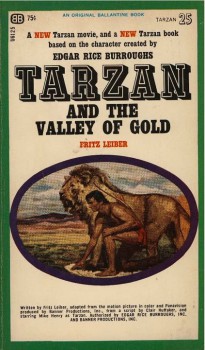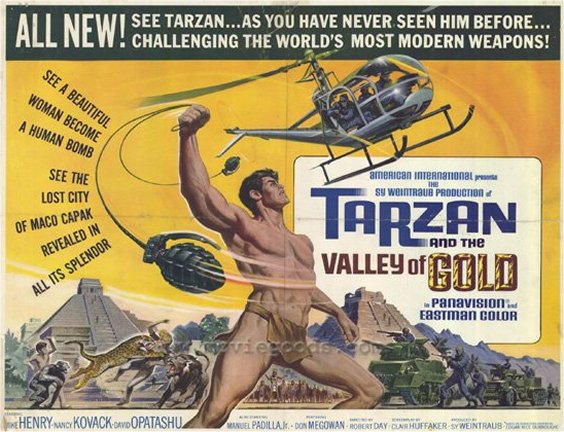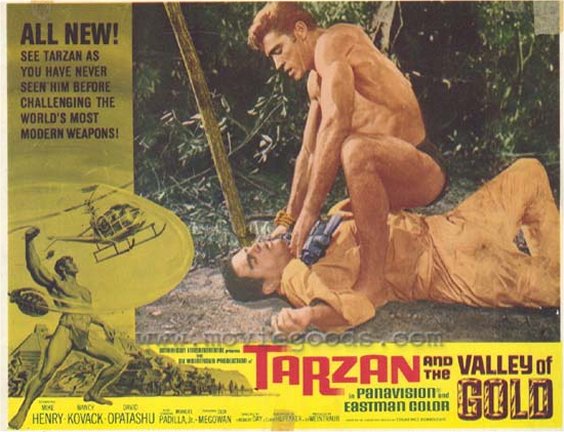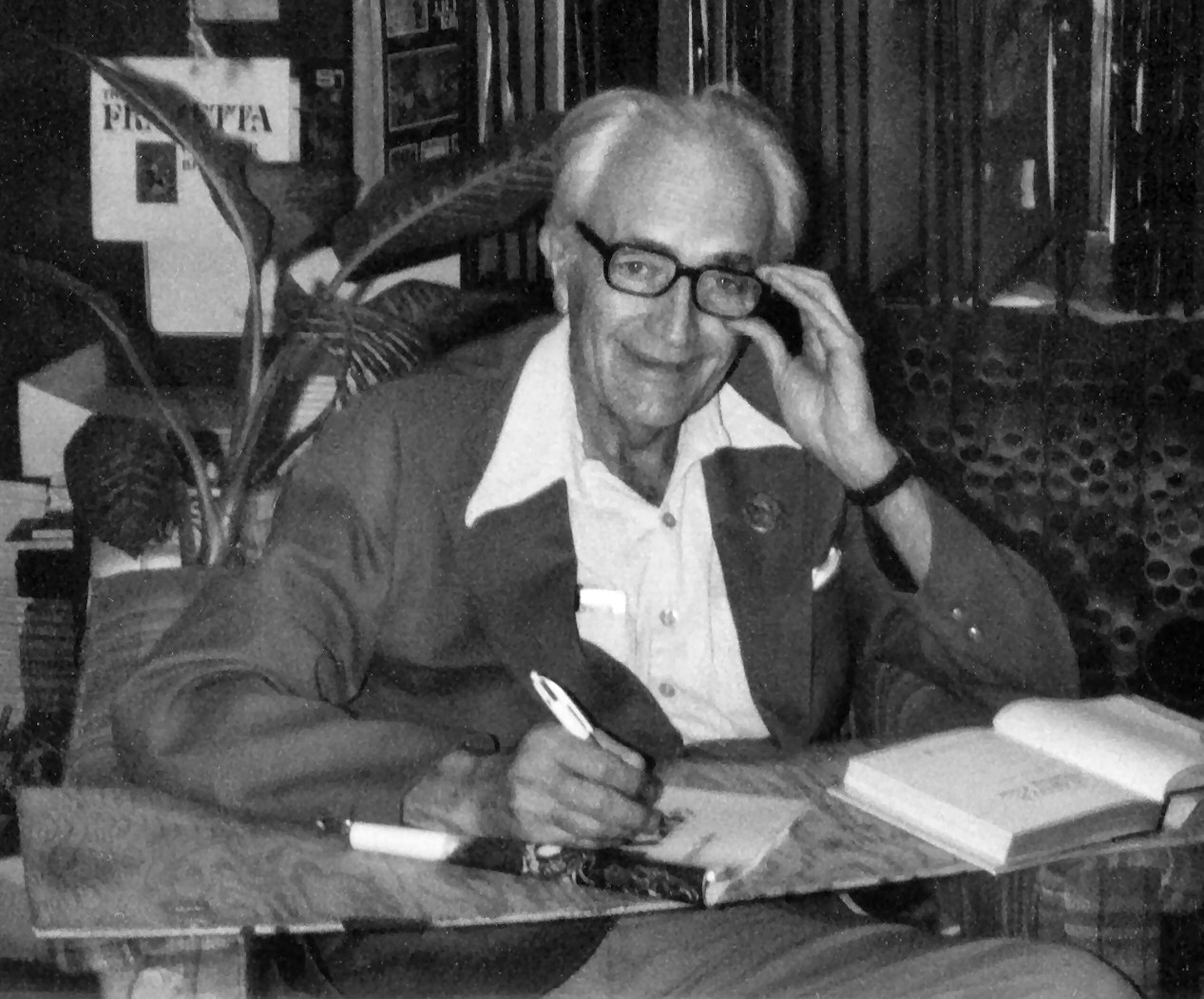Tarzan and the Valley of Gold, Part 2: The Fritz Leiber Novelization
 Tarzan and the Valley of Gold (1966)
Tarzan and the Valley of Gold (1966)
By Fritz Leiber, from a Screenplay by Clair Huffaker
I have never watched a movie and then immediately felt an urge to “Read the Jove Paperback” (or whatever publisher released the tie-in). Movie novelizations are marketing after-thoughts and I think most readers pick them up as after-thoughts as well. A wanderer in a bookstore might spot a paperback copy of Blockbuster Film You Kinda Enjoyed and think to herself, “Hey, this might be a fun airplane read.”
But there aren’t as many bookstores to wander in these blighted times and with the gap narrowing between the time of a film’s release and its DVD/Blu-ray popping up in the impulse item rack of the supermarket, the niche genre of the novelization has entered a slow death cycle. Fewer big tent pole movies are getting the prose treatment.
I’ve read more than my sane share of novelizations, the majority from Alan Dean Foster because Alan Dean Foster rocks (he even responded to my review of his Clash of the Titans novelization). But with Tarzan and the Valley of Gold, I found myself for the first time in the peculiar reverse position of wanting to see a movie because of the novelization.
The reason: Fritz Leiber.
The idea of one of the Grand Masters of speculative fiction, an icon of sword-and-sorcery, penning any genre film novelization is delicious. And penning a Tarzan novelization … that’s the colored sprinkles on top of the chocolate doughnut. Novelization or not, it’s a Fritz Leiber Tarzan book.
But before reading Leiber’s Tarzan and the Valley of Gold, I needed to see the movie Tarzan and the Valley of Gold. It is, after all, the source material. The original. I needed to play fair.
Tarzan and the Valley of Gold is a candy corn B-movie romp (my review in Part 1) with decent re-watch value. It gets nowhere near the quality of the earlier “New Look” Tarzan films with Gordon Scott — Tarzan’s Greatest Adventure and Tarzan the Magnificent — yet it manages to move the Ape Man, played by Mike Henry, smoothly into the arena of 1960s James Bond espionage. But the Leiber novel demolishes the movie. I have come across novelizations that are superior to their films, such as Alan Dean Foster’s takes on The Black Hole and Krull. But Leiber not only leaves his source choking in the dust, he breaks apart all expectations of what a novelization is supposed to be. You only need to compare running time and page count to see the difference. Tarzan and the Valley of Gold lasts a lean ninety minutes. Tarzan and the Valley of Gold takes up 317 closely printed pages. The novelization doesn’t contain a few embellishments; it is a substantial re-imagining and enlarging.
The standard operating procedure for a movie tie-in: While the film is in pre-production, the Marketing Department hires Alan Dean Foster to write the novelization. If they can’t get Foster, they hire somebody else. The author gets the current draft of the script and writes the book based on that, plus whatever production artwork and footage the filmmakers provide. The writer stays close to the script, adding whatever is necessary to work best within the prose form. The differences between the released film and the novelization are usually due to post-production changes.
 But Leiber’s Tarzan and the Valley of Gold bursts out of the narrow limits of the film to create an epic that elaborates and deepens every aspect of the script. The characters are the same, the sequence of events similar, and most of the major scenes show up in semi-recognizable shape. The story follows the movie’s outline: Tarzan comes to the Americas at the request of a friend after a strange boy emerges from the jungle with evidence of the existence of a fabled lost city, Tucumai. The villainous Augusto Vinaro, who wishes to possess the wealth of Tucumai for himself, kidnaps the boy, killing Tarzan’s friend in the process. Tarzan pursues the kidnappers into the rainforest with the aid of a loyal lion and chimpanzee. After Tarzan rescues the boy, Ramel, he races to reach Tucumai before Vinaro’s private army can get there and loot the place. This leads to a showdown in the ancient city among its pacifist inhabitants, with Tarzan facing Vinaro’s powerful henchmen, Mr. Train, and gaining an ally in Vinaro’s jilted mistress Sophia.
But Leiber’s Tarzan and the Valley of Gold bursts out of the narrow limits of the film to create an epic that elaborates and deepens every aspect of the script. The characters are the same, the sequence of events similar, and most of the major scenes show up in semi-recognizable shape. The story follows the movie’s outline: Tarzan comes to the Americas at the request of a friend after a strange boy emerges from the jungle with evidence of the existence of a fabled lost city, Tucumai. The villainous Augusto Vinaro, who wishes to possess the wealth of Tucumai for himself, kidnaps the boy, killing Tarzan’s friend in the process. Tarzan pursues the kidnappers into the rainforest with the aid of a loyal lion and chimpanzee. After Tarzan rescues the boy, Ramel, he races to reach Tucumai before Vinaro’s private army can get there and loot the place. This leads to a showdown in the ancient city among its pacifist inhabitants, with Tarzan facing Vinaro’s powerful henchmen, Mr. Train, and gaining an ally in Vinaro’s jilted mistress Sophia.
This sketch of events acts only as a launching pad for a vast Tarzan story that adheres to Burroughs’s timeline and backstory for the character, not the abbreviated one from the movie series that started with Johnny Weissmuller. Leiber enhances the mythology, the setting, the action, and the characters in such a way that the movie feels like a trimmed down adaptation of the book. Had the movie done most of what happens in the pages of the novel, Tarzan and the Valley of Gold would have been one of the most expensive films ever produced at the time and rivaled the contemporary Bond movies in scope.
The fresh approach begins with Chapter 1: “The Gate of Fright,” which Leiber wrote as a audition piece to convince Hulbert Burroughs at ERB, Inc. to take a chance with the idea. (No author aside from Burroughs had yet written an authorized Tarzan novel. It was Ian Ballantine at Ballantine Books who approached ERB, Inc. with the novelization proposal.) The chapter has Tarzan escaping death in a bullfighting arena. The movie also opens with an action scene in a bullring — but the one in the novel is a new sequence that takes place a few days before the events of the film. It isn’t even until Chapter 6 that Leiber gets to anything that happens on screen, where he replaces the movie’s assassination attempt in an empty arena with an assassination attempt in a carwash. That’s no loss, since the earlier bull fight scene is an astonishing piece of action writing the film could never approach. It also captures ERB’s Tarzan in short, strong brush strokes: the Lord of the Jungle refuses to harm the bull and instead mounts it to turn it against the picadors.
Where the movie takes place entirely within Mexico where it was filmed, the novelization has Tarzan begin in Mexico and then fly to Brazil and move into the rainforests of the Mato Grosso. Tucumai, a generic “lost city” in the film, gains a fascinating history as the hidden outpost of the Incas where the they hid their gold from Pizarro’s raiders. The exotic backdrop of the movie becomes the foreground of the novel, and Leiber never misses a chance to delve into the setting and make it come alive to all the senses.
 Although Leiber shows a strong understanding of the style of Edgar Rice Burroughs, the author he more overtly references is Ian Fleming. The author of the James Bond novels appears in the dedication for Tarzan and the Valley of Gold, and it’s an appropriate acknowledgment. Leiber subsumes his own witty style to embrace Fleming’s adoration for exotic details and fascinating travelogue side trips. Fleming could make two people having dinner a riveting read, and Leiber pulls the same trick with Tarzan’s airplane trip to the Mato Grosso. Like Fleming, Leiber finds ways to provide travelogue color to the story without stopping the forward motion of events.
Although Leiber shows a strong understanding of the style of Edgar Rice Burroughs, the author he more overtly references is Ian Fleming. The author of the James Bond novels appears in the dedication for Tarzan and the Valley of Gold, and it’s an appropriate acknowledgment. Leiber subsumes his own witty style to embrace Fleming’s adoration for exotic details and fascinating travelogue side trips. Fleming could make two people having dinner a riveting read, and Leiber pulls the same trick with Tarzan’s airplane trip to the Mato Grosso. Like Fleming, Leiber finds ways to provide travelogue color to the story without stopping the forward motion of events.
Throughout, Leiber displays how much he understands the literary Tarzan. He explores the character’s history, goes into more detail about the apparent supernatural longevity the Lord of the Jungle has obtained (Burroughs hinted at this in Tarzan and the “Foreign Legion”) and provides footnotes for numerous references to his earlier adventures. The movie series of the time ignored Tarzan’s identity of John Clayton, Lord Greystoke, but Leiber embraces the duality that gives the character a special appeal.
The villain Augustus Vinaro is the biggest triumph of the book. Burroughs was never sure-handed with his villains — he excelled with heroes and supporting characters — but Leiber goes full Fleming to make Vinaro a worthy counterpart of Hugo Drax, Auric Goldfinger, and Dr. Julius No. The movie makes Vinaro a generic greedy bad guy who does “bad guy stuff,” like blowing up his own office to take out a flunky, because those are the sort of things a super criminal is supposed to do. The novel explores Vinaro as a worshipper of death with deep psychotic drives. The gimmick of giving people exploding watches turns into a key part of the character’s psychology of ritualized murder. Blowing up his office to take out one man is now how Vinaro “consecrates with blood” his new castle. His relationship with his mistress, which the movie bats around for the sake of having a female character, is unnerving and queasy, and it logically leads to trapping Sophia with a necklace laced with explosives. Vinaro dies a more satisfying death in the novelization: the film gives him an ironic send-off that works fine on screen, but the novel’s psychopathic Death God needs to go out in an even bigger way — and Leiber delivers on this.
A smaller triumph is the portrayal of henchman Mr. Train. The strongman and martial arts expert receives significant build-up as a physical adversary to Tarzan. This culminates in a staged fight between the two that Vinaro arranges for his own enjoyment; it’s a nod to ERB’s many gladiatorial set pieces. This is the action highlight of the book, and the movie has nothing like it, only a quick fight between the two during the rushed finale.
Leiber solves a major problem with the movie and makes it one of the book’s strength. In the film, the inhabitants of Tucumai renege on their vow of non-violence against Vinaro’s men, and their chieftain Manco Capac takes care of killing the villain himself. The script only offers up a shrug for this: “Sometimes killing is necessary.” A bit forgivable in a basic adventure film, but it’s still lazy writing.

Leiber makes the necessity of killing a running theme that reaches its apex in the attitudes of the people of Tucumai. Throughout his adventure, Tarzan hears of the Portuguese slogan Morrer se preciso fôr, matar nunca! “Die if necessary, but never kill.” He admires the idea, but his animal instincts do not allow him to carry it out to the letter. But the people of Tucumai remain faithful to their vow of avoiding killing and never using weapons — and they still overcome Vinaro’s soldiers in clever ways and with a hint of supernatural powers. Instead of leaving the Tucumaians with the lesson that maybe they should try killing folks for a change, it is Tarzan who ends up with a lesson to contemplate at the close. Writers can take a lesson from this as well: a plot hole can become a plot victory if approached as a challenge.
Tarzan and the Valley of Gold has remained out-of-print for decades. It deserves a wider audience through e-book publication, although I’m unsure if ERB, Inc. currently holds the sole rights. The copyright page of my 1966 printing attributes ownership to ERB, Inc. and Banner Productions, the company that produced the film. Banner Productions no longer exists, and Warner Bros. now owns the film rights — although not necessarily the rights to the novelization. Depending on the contract originally made with Fritz Leiber, his estate may also get royalties. If there are multiple parties involved, I hope they can come to an agreement and make available — in one format or another — one of the finest Tarzan novels from any author.
Fun Novelization Trivia: The 1978 SF-themed thriller Capricorn One has two novelizations that were published simultaneously. Ron Goulart wrote the U.S. version, and Ken Follett — yes, Pillars of the Earth Ken Follett — wrote the U.K. version under the pseudonym Bernard L. Ross.
Ryan Harvey is a veteran blogger for Black Gate and an award-winning science-fiction and fantasy author who knows Godzilla personally. He received the Writers of the Future Award for his short story “An Acolyte of Black Spires,” and his story “The Sorrowless Thief” appears in Black Gate online fiction. Both take place in his science fantasy world of Ahn-Tarqa. A further Ahn-Tarqa adventure, “Farewell to Tyrn”, the prologue to the upcoming novel Turn Over the Moon, is currently available as an e-book. You can keep up with him at his website, www.RyanHarveyWriter.com, and follow him on Twitter.
[…] is only Part 1 of my look at Tarzan and the Valley of Gold. The topic merits a second installment because of the novelization released to tie-in with the film. Most novelizations aren’t worth […]
Ryan,
Wow! Great review. I had no idea Leiber had ever DONE a Tarzan book… let alone one that sounds this fabulous.
Nice one!
I was always vaguely aware that Leiber had written a Tarzan novel, but I was never interested enough to seek it out – until now!